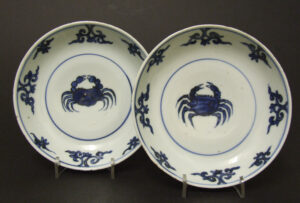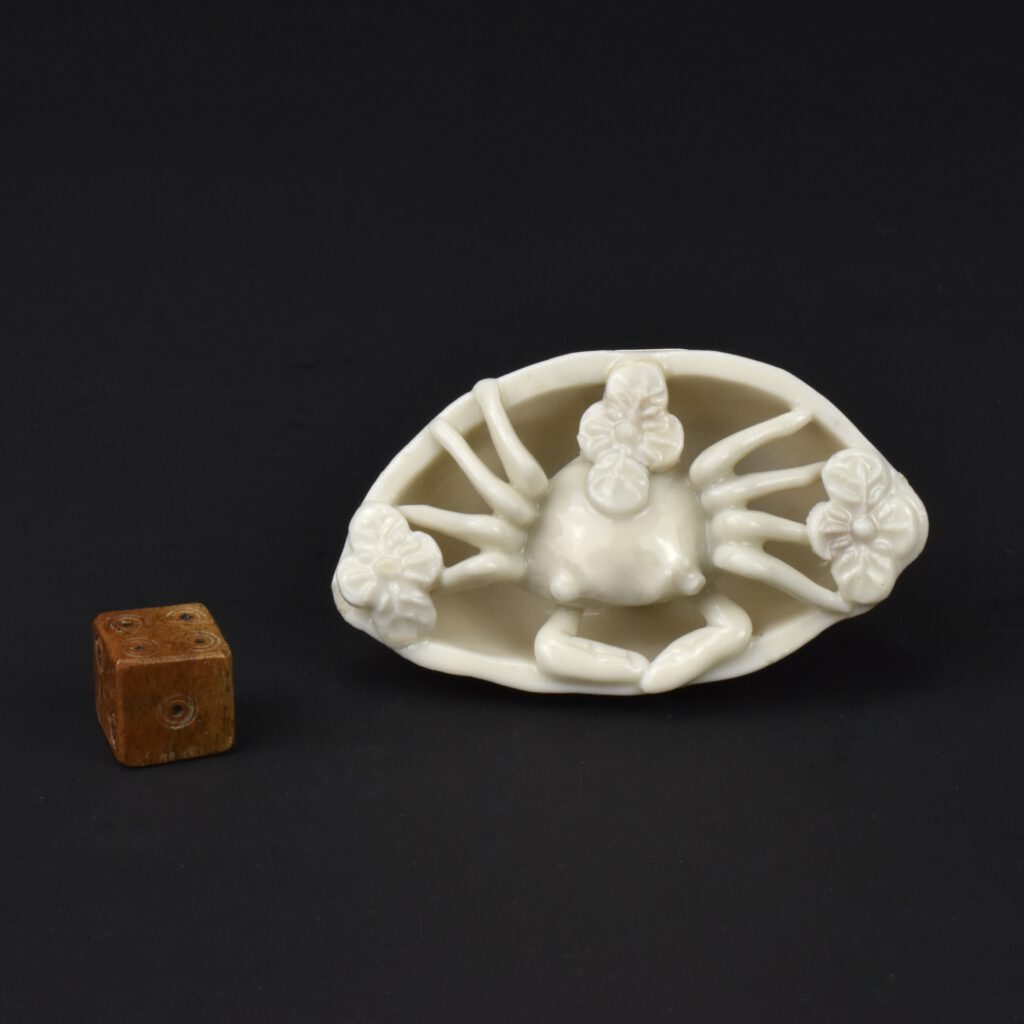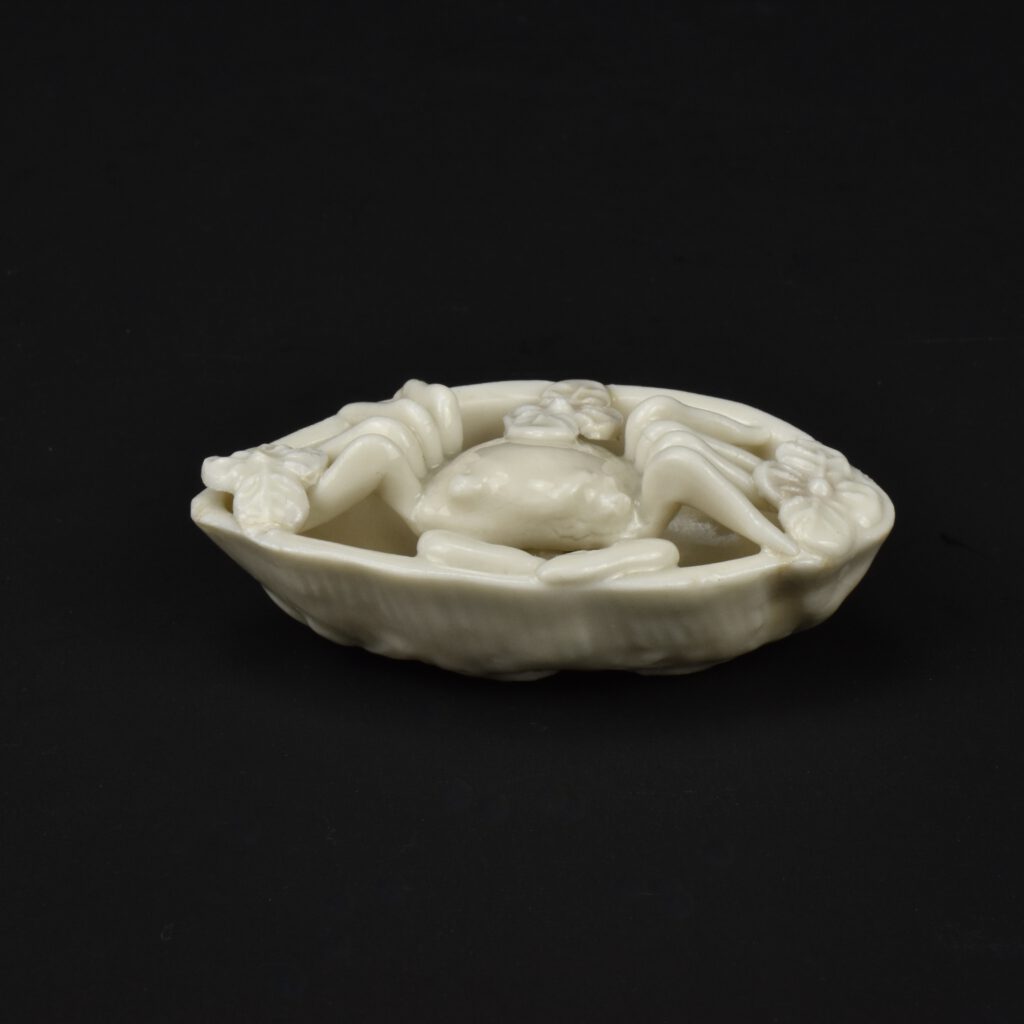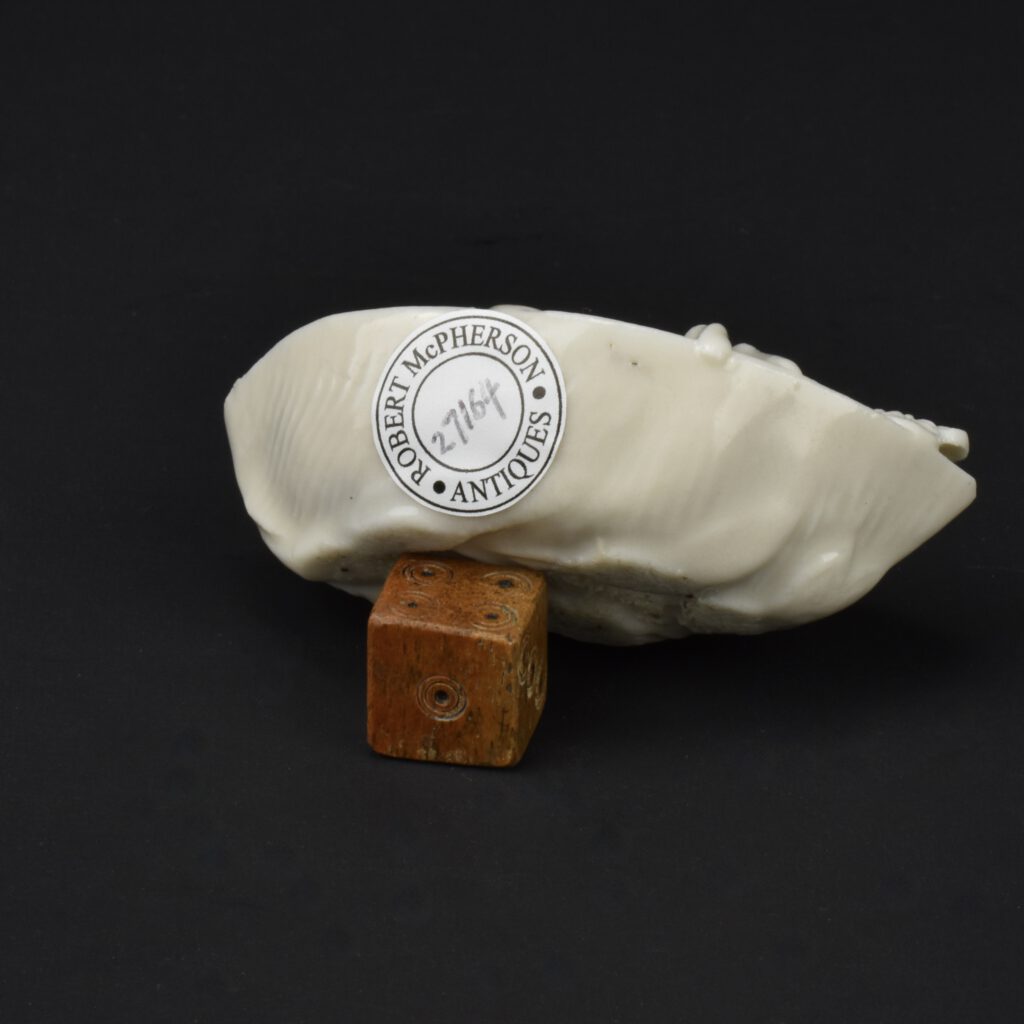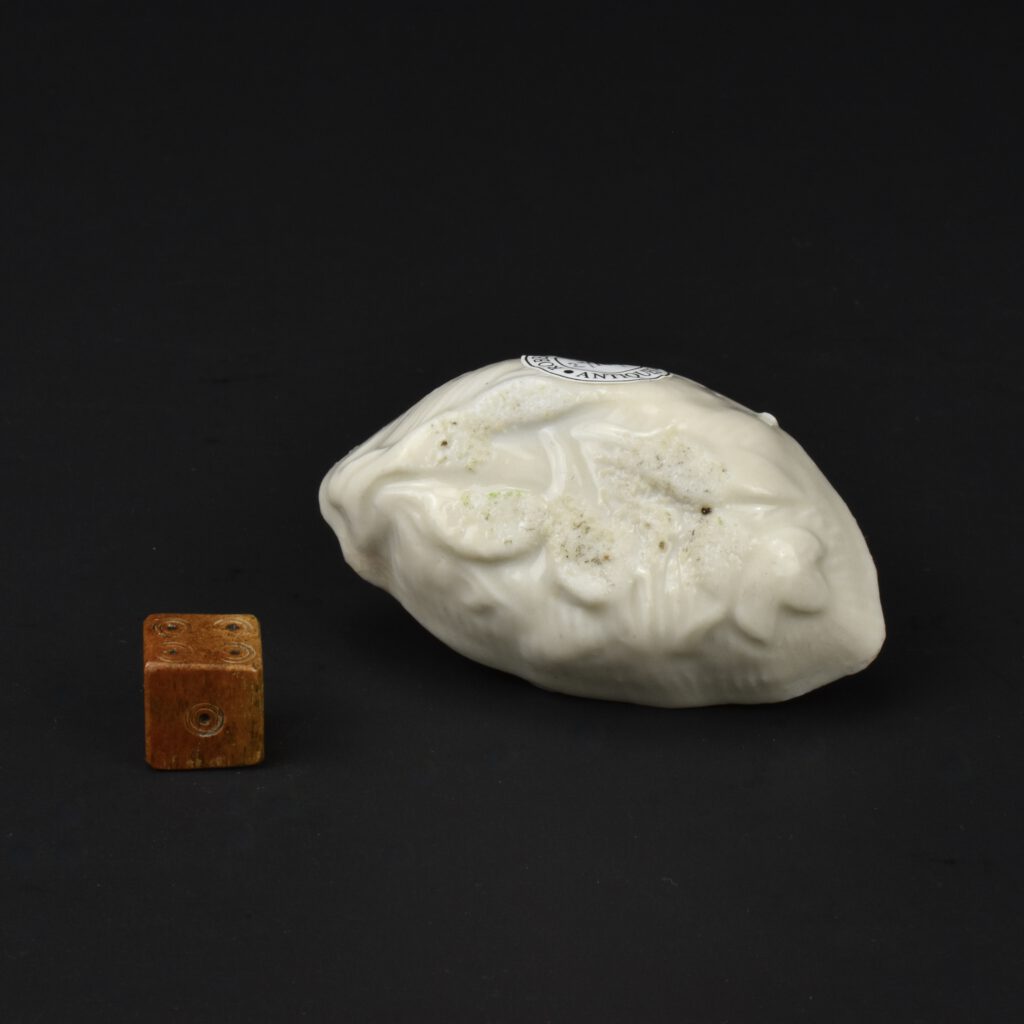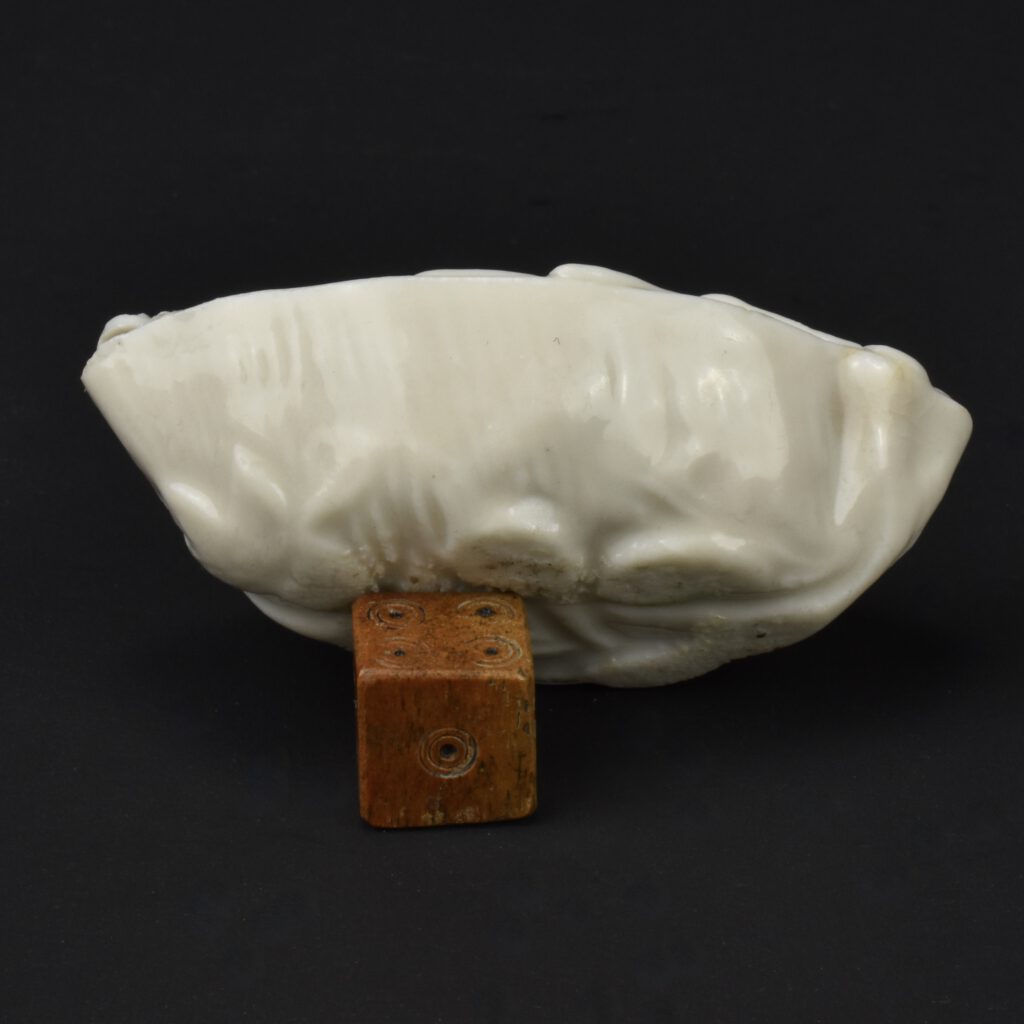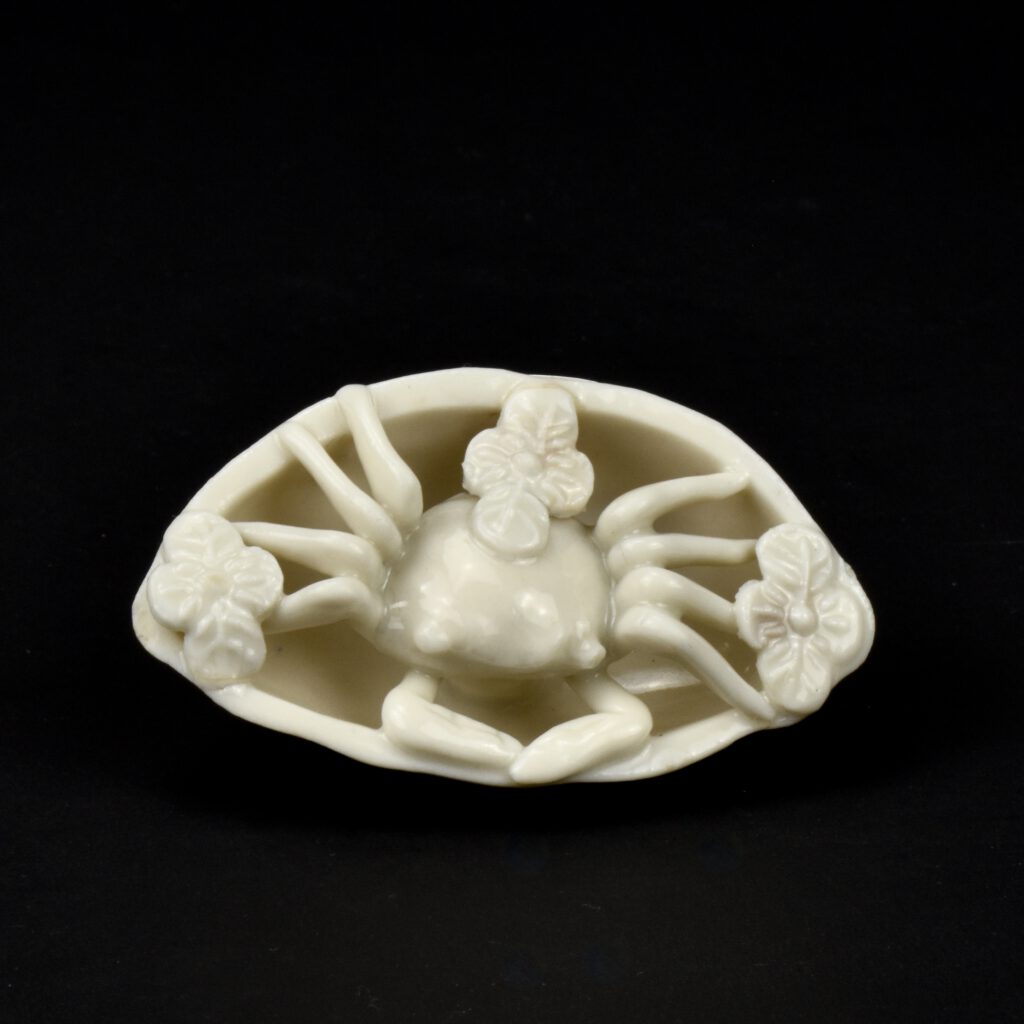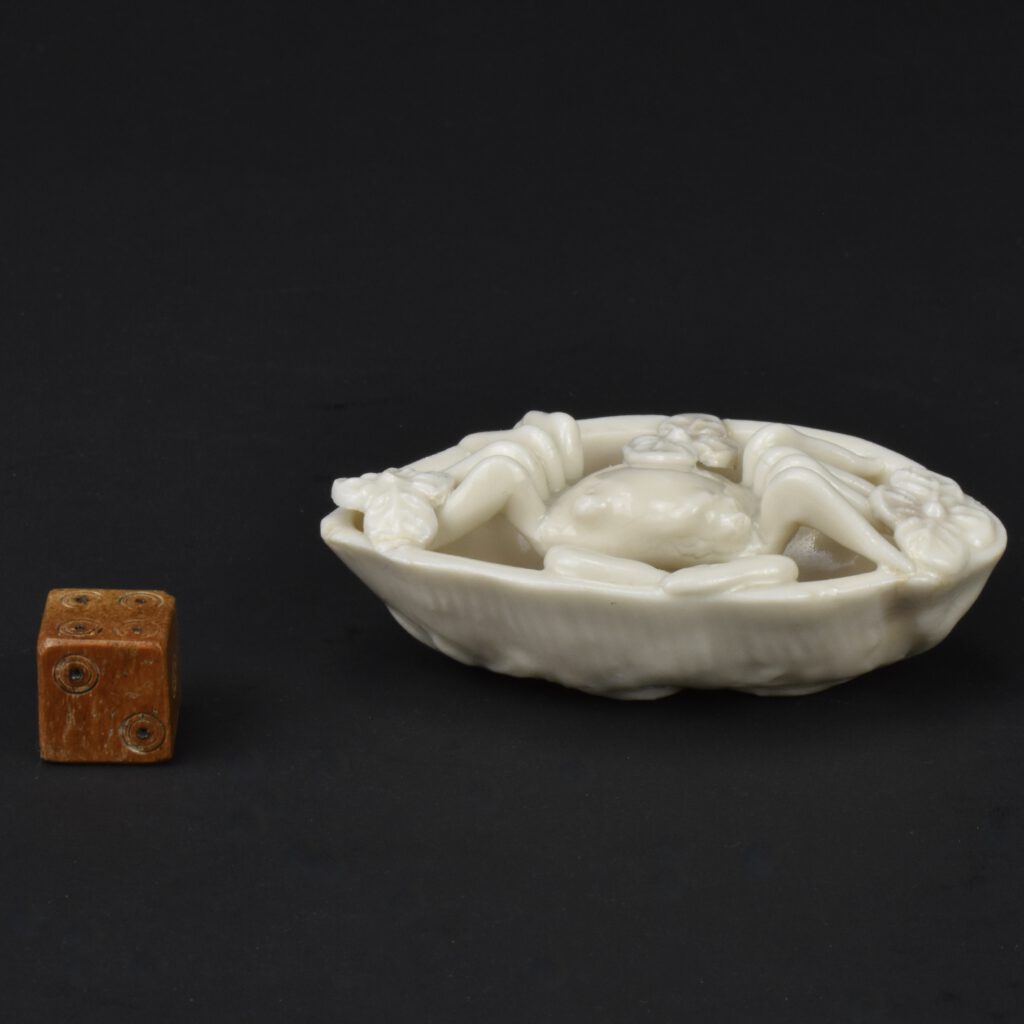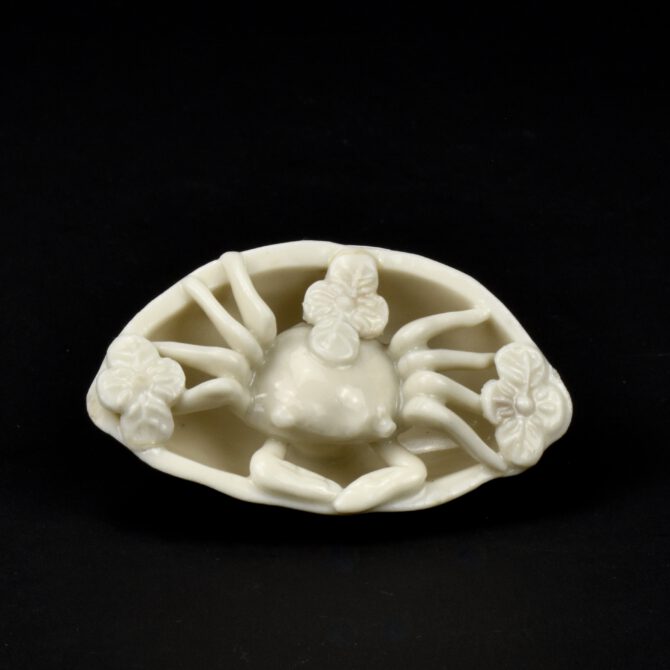
A Kangxi Blanc de Chine Porcelain Crab Form Water-Pot
A Small Kangxi Blanc de Chine Porcelain Water Pot Dehua kilns, Fujian province c.1690-1710. Modelled as a crab astride a lotus leaf and with applied leaves. Small items like the present example were made for scholars, as a novelty and to serve a practical function, to carry water to mix with ink. This model is very close in style to a water pot from the Vung Tau Cargo we sold some time ago, see information lower down on this page. These were made for the Chinese at home but also Chinese in Southeast Asia, so it is not surprising to water pots in the context of a shipwreck cargo. It is clear that the whimsical novelty of these objects also appealed to Western tastes, so water pots like the present example, as well as Blanc de Chine seals, models of Guanyin and Budai were shipped to Europe as well. Xie, Crabs are normally depicted on Chinese porcelain in the context of other marine crustacea together with aquatic plants. On their own the appear only rarely and as single creatures they have a different meaning. They are used to represent achievement as Xie is a homonym for the those who have passed the first examination towards official rank, Xie. In folklore, the crab can repel bad magic and restore a man’s potency.
SOLD
The term `Scholar’s object` refers to something used by a Chinese scholar in his or her studio, it includes everything from scroll-tables, desks, screens, and chairs to the smaller objects found on the scholar’s desk. The material used for these desk objects varied greatly, from bamboo to stone, ivory, wood, and metal, but ceramics were by far the most commonly used material, even though ceramics rated lowest in ranking of importance. Bamboo, ivory, or wood might not be durable enough and metal was sometimes too heavy but ceramic objects could be thrown or moulded into an infinite variety of forms. Most of the objects made centred around the functions of writing and painting. Brushpots of different sizes and shape were needed to take the various types of brush, the same applies to brush rests. Water-droppers for adding water to dry solid ink when it was ground on an inkstone, as well as the inkstones themselves were all needed, as were water-pots and brush-washers. All of these could be made of porcelain. But these were not merely functional items, they conveyed symbolic mean, often enhancing scholarly virtues and the wish for longevity. They were meant to inspire the writer, poet, and artist but it is clear they could also exhibit a great sense of humour, sometimes having almost childlike quality. Objects for the scholar’s desk were made from many different ceramic bodies, during the Song Dynasty (960-1279) Qingbai porcelain was most frequently used, often in moulded forms. Blue and white porcelain objects became popular from the Ming dynasty onwards. By 17th and early 18th century, Blanc de Chine, and biscuit porcelain with coloured glazes such as green, aubergine or turquoise were also popular. Some of these objects were shipped to Europe at the time. The records of the Dashwood, a British trading vessel, were sold at in September 1703, this Supra-cargo, include 10,800 `square toys`. These were Blanc de Chine seals, I have bought and sold many of these over the years. Some are uncut, some have mould seals to the base and could have been used in China, there seals that were engraved, its likely these were not exported. However, the label, ‘square toys’, shows that in Britain they were seen as novelties to show friends and to be on display in cabinets. I’m not sure if the Chinese scholarly class would have approved.
- Condition
- In very good condition, some minute stress lines at the end of the laws where they meet the edge of the lotus leaf. One minor frit to the rim, hidden under a leaf.
- Size
- Length : 6.4 cm (2 1/2 inches)
- Provenance
- N/A
- Stock number
- 27164
- References
- For a Kangxi Blanc de Chine porcelain water pot from the Vung Tau Cargo of this form from c.1690 see : Porcelain From The Vung Tau Wreck, The HallStrom Excavation (Christian J.A. Jorg and Michael Fletcher published by Sun Tree Publishing Ltd. ISBN 981-04-5208-X) page 86 Fig. 86. For a Blanc de Chine Kangxi porcelain water pot, dated to c.1690, of very similar form but with the addition of applied prunus flower-heads see : Blanc de Chine (Introduction by John Ayers, S.Marchant & Son, 2006. ISBN 0-9554009-0-2) page 93, plate 61.
Information
Blanc de Chine Porcelain :
The porcelain known in the West as Blanc de Chine was produced 300 miles south of the main Chinese kiln complex of Jingdezhen. The term Blanc de Chine refers to the fine grain white porcelain made at the kilns situated near Dehua in the coastal province of Fujian, these kilns also produced other types of porcelain. A rather freely painted blue and white ware, porcelain with brightly coloured `Swatow` type enamels as well as pieces with a brown iron-rich glaze. However it is the white blanc de Chine wares that have made these kilns famous. The quality and colour achieved by the Dehua potters was partly due to the local porcelain stone, it was unusually pure and was used without kaolin being added. This, combined with a low iron content and other chemical factors within the body as well as the glaze, enabled the potters to produce superb ivory-white Blanc de Chine porcelain.
Blanc de Chine from Shipwrecks :
By far the largest category of ceramics found on shipwrecks is blue and white porcelain from the kilns at Jingdezhen. Blanc de chine porcelain is sometimes found among the cargo`s recovered but the majority of cargo`s don`t contain this white porcelain from the Dehua kilns in Fujian province. Because blanc de chine porcelain is so difficult to date pieces recovered from shipwrecks are especially important in establishing a credible chronology. Many blanc de chine forms were used over a very long time, indeed even over hundreds of years, pieces recovered from shipwrecks enable subtle changes that occurred to be attributed to precise periods. The 579 objects recovered from the Hatcher wreck of c.1643 represent the most important group of blanc de chine porcelain found so far. 439 of the pieces were bowls, most of which were made as nests of five, but many other forms are represented including archetypal blanc de chine forms such as censers, a guanyin, trick cups as well as standard forms such as vases. Small models of guanyin were also recovered from the Vung Tau Cargo of 1690 as well as acolytes from larger guanyin figures. There were many bowls, dishes, boxes with covers as well as a few water-droppers. There was white porcelain found on the wreck of the Geldermalsen, however this Nanking Cargo porcelain came from the Jingdezhen kilns and so is not blanc de chine.
Crab Xie
Xie, Crabs are normally depicted on Chinese porcelain in the context of other marine crustacea together with aquatic plants. On there own the appear only rarely and as single creatures they have a different meaning. They are used to represent achievement as Xie is a homonym for the those who have passed the first examination towards official rank, Xie. In folklore, the crab can repel bad magic and also restore a mans potency.
Robert McPherson - Sold Archive.
Kangxi Blanc de Chine Porcelain Water Pot from the Vung Tau Cargo.
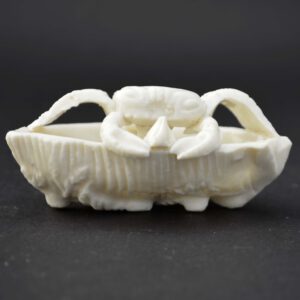
SOLD
Condition
In excellent condition with only very minimal glaze degradation to immersion in sea water. A firing crack across the legs of the crab.
Size
Length : 8 cm ( 3 1/4 inches)
Provenance
The Vung Tau Cargo, Chinese Export Porcelain. Christie`s Amsterdam, 7th and 8th of April 1992 (no label). From a small collection of pieces from the Vung Tau cargo.
Stock number
24799
References
For a Kangxi Blanc de Chine porcelain water pot from the Vung Tau Cargo of this form from c.1690 see : Porcelain From The Vung Tau Wreck, The HallStrom Excavation (Christian J.A. Jorg and Michael Fletcher published by Sun Tree Publishing Ltd. ISBN 981-04-5208-X) page 86 Fig. 86. For a Blanc de Chine Kangxi porcelain water pot, dated to c.1690, of very similar form but with the addition of applied prunus flower-heads see : Blanc de Chine (Introduction by John Ayers, S.Marchant & Son, 2006. ISBN 0-9554009-0-2) page 93, plate 61.
A 17th Century Blanc de Chine Crab Water-Dropper.
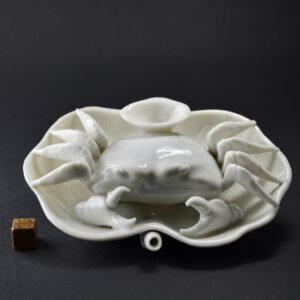
Condition
Repaired, there is an old repair to the back, a large section has been broken out and restuck. Within this section there is a related restuck chip only visible from above. The U-shaped section that has been broken out is 60 x 35 mm. There is a flake chip to the back of the water inlet behind the crab 10 x 10 mm.
Size
Diameter : 14.7 cm (5 3/4 inches)
Sold Archive 25045
References
For a very similar Blanc de Chine porcelain water dropper dated to c.1640 see : Exhibition of Blanc de Chine (S.Marchant & Son, London, 1985) plate 33, offered for sale at £2,000. For a further Blanc de Chine water dropper dated as Ming c.1640 see : Exhibition of Blanc de Chine (Marchant, London, 2014. ISBN 978-0-9568400-7-3) page 96, plate 72. Offered or sale at £12,000.
A Pair of Ming Dishes Decorated with Crabs
Robert McPherson Antiques
